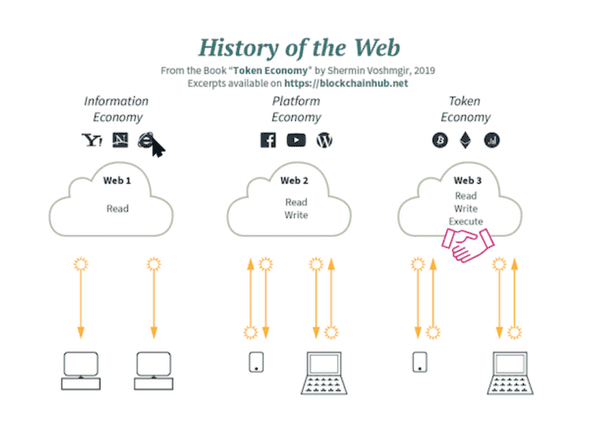Web is composed of many technologies woven together to provide various services for users. As these technologies evolve, we see improvements in the services they provide. The evolution of Web as we know can be understood as below.
Web 1.0 made it possible to build content on the Internet in the form of Websites. Similar to how the content is in Books, a digital version of content published as Web Pages can be accessible anywhere using a Website on the Internet. We saw hundreds of thousands Websites full of knowledge popup all over the Internet using Web 1.0 technologies. We saw many businesses with physical presence started opening Internet Websites to extend their users through e-commerce. We saw hundreds of services developed around distribution and discovery of physical goods or digital content like AltaVista, Netscape, Google, Amazon!.
Web 1.0 technologies enable mass consumption of physical or digital goods & services where central entities produce the content or products and users are the consumers of content or products.
Web 2.0 technologies made it possible to further scale the content generation and accessibility to masses through Social Networks and Mobile phones. With these technologies, accessibility of the Web in the form of Mobile Apps, we can reach more than 1.8 billion websites that exist now over the Internet, all available on the palm of our hands. Not only that, we have services like Wikipedia, Instagram, YouTube, TikTok etc. that allows users to publish or review content. We have services like Facebook, Twitter, Discord etc. that allows us to have social interaction over the Internet.
Web 2.0 technologies not only enables mass consumption but also mass production of content. Users can generate or review content which other users can benefit from, without depending on central entities to create content.
Web 3.0 is the new generation of technologies that would likely solve constraints associated with Web 2.0
Constraints of Web 2.0 Technologies
Ownership : The users create the content - however, it is owned by the 'Platform' that is used to publish the content. Think about an article published on LinkedIn or Facebook. Who owns that content?
Privacy : Users are not creating value by using the products, instead Users are becoming the Products, creating value to the big entities who own the platforms. How you use the products, when you use products, which location/device you use the products from, even what other products you use is not private information while using these platforms.
Value : Users are not really benefited by using services, instead Users are serving the entities who own these services. These platforms are monetizing user data to benefit the platforms who own them.
Control : Users are not becoming influencers on social networks, instead Users are being influenced by the entities who control these social networks. The algorithms that generate feeds we see on social platforms are not fully controlled by users, instead it is increasingly being controlled by central platforms who own social networks.
Trust : Users can not trust their data or privacy to remain safe with centralized entities. These platforms more often fail to prevent hacks.

Leave a Comment